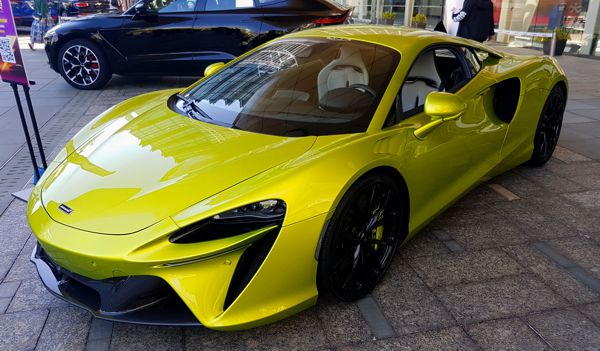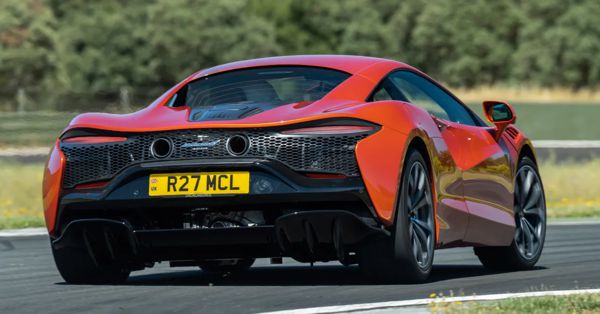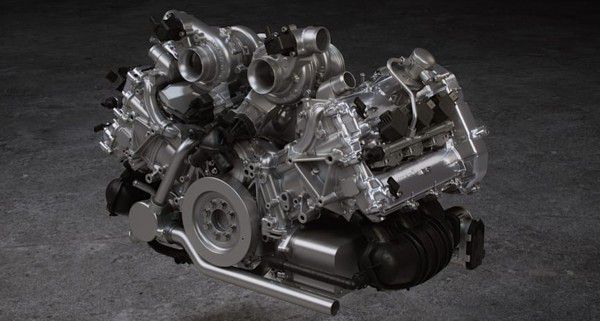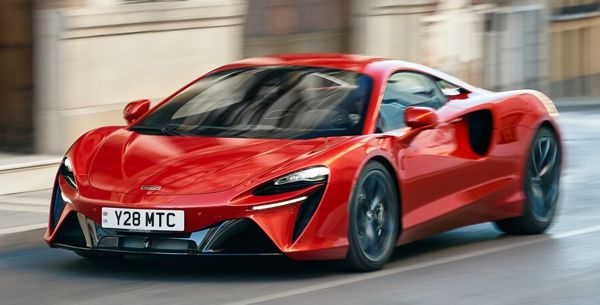| Published
on 5
Nov 2022 |
All rights reserved.
|
|
|

|
|
Long
delayed McLaren entry-level model finally arrives.
|
|
It’s been a while since we
heard the introduction of Artura. McLaren announced its new entry-level
production model in last February and scheduled to start delivery in
October. Unfortunately, the production was held back at the last
minute, citing software glitches as the main reason. Just a couple of
weeks later, I saw a gold Artura (pictured) parked under my work place
in November, thought the problem must have been sorted out, otherwise
McLaren would not have taken it to the Far East for promotion. Somehow,
nothing was heard in the next 8 months. By June this year, the
international road test event finally happened in Spain. Unfortunately,
many motoring journalists reported all sorts of software failures and
quality glitches. It shows how volatile the supercar business could be…
A few years back, McLaren was still enjoying profit and fames, in a
good position to challenge the domination of Ferrari and Lamborghini.
Just an eyeblink later, it got into deep financial trouble, had to sell
its valuable McLaren Technology Center in Woking and lease back. 1200
employees were made redundant out of the total workforce of 4000,
including its CEO. That
might be the root cause of its software and quality problems. While
Covid pandemic is usually the reason to blame, the British supercar
maker’s problem lies as much on its unsustainable business model –
over-reliance on one basic platform for all its cars, lacking a
diversity of products. Yes, it introduced more nameplates in the last
decade than you can remember in a lifetime, but they are not remarkably
different, and therefore all are focused to the hardcore end of the
market, stealing sales from each other. Eventually, all potential
customers have been fulfilled, and it becomes difficult to find new
customers.
I don’t know if Woking realizes this root cause, but from the new
Artura, it seems that lesson has yet to be learned, because it looks
very much like its predecessor, the 570S. The key difference is only
upgrading to V6 hybrid power, incidentally the same as Ferrari 296 GTB.

|
|
Looks
very much like 570S, where is the progress?
|
|
The Artura is nearly the same size as the 570S, although its wheelbase
is shortened by 30 mm. No matter viewing from the front, side or back,
its proportion, its shape, its lines and even many design details are
very similar to its predecessor. That’s not to say it looks
unattractive, but I am not sure if it is a step big enough for existing
McLaren owners to consider upgrade.
Excluding composite front and rear fenders, the entire body work is
made of aluminum. Underneath the skin is an all-new architecture. It
features a new carbon-fiber tub which is now built by McLaren itself.
The tub has extended B-pillar mountings and integrated battery
compartment, no wonder weight is up by 6 kg to 82 kg. As before, the
front crash structure is aluminum, as is the rear subframe for mounting
the powertrain and rear suspensions. The windscreen surround has been
upgraded from steel to carbon-fiber.
The battery pack is placed just behind the passenger cell at floor
level. Its capacity is only 7.4 kWh, giving the Artura an electric
range of only 30 km (19 miles). Behind engine is a new 8-speed
dual-clutch gearbox. An axial flux electric motor is positioned between
the engine and DCT and is contained inside the bell housing of the
transmission. It offers a maximum output of 95 hp and 166 lbft, less
powerful than its Ferrari rival (163 hp / 232 lbft), but still the
electric power can fill the torque gap during each gearchange,
resulting in relentless acceleration.
Predictably, to cheat WLTP emission test, the car always starts at EV
mode – in which you can drive it up to 81 mph – so to achieve a CO2
rating of 129 g/km, assuming you have charged the battery to full at
home. Once the battery runs low, the Artura uses the engine to recharge
it. Note that it is not capable of regenerative braking, as McLaren
said brake feel could be compromised. We found its Ferrari rival has no
such problems though. Admittedly, Ferrari uses state of the art
brake-by-wire system to enable them to fine tune the transition between
mechanical and regenerative braking. The McLaren stays with
conventional hydraulic braking. Development cost and manpower might be
the true reason for its choice.
 |
|
Torque-fill
electric motor gives a relentless acceleration.
|
|
The entire electric powertrain adds 130 kg to the car, resulting in a
DIN kerb weight of 1498 kg, or nearly 90 kg more than the 570S. The
electric motor and battery pack weigh 15.4 kg and 88 kg, respectively.
By electrifying the power unit, McLaren is able to downsize from V8 to
V6 engine. Codenamed M630, this is a 3.0-liter V6 with an especially
wide, 120-degree V-angle, incidentally the same as Ferrari again. It is
once again built by Ricardo exclusively for McLaren. The wide angle
enables a lower center of gravity as well as common crankpins to be
shared between two cylinders, resulting in compact dimensions.
Moreover, the V6 has undersquare combustion chambers with 84 mm bore
and 90 mm stroke to realize a swept volume of 2993 c.c., reducing the
length further. It has a hot-vee architecture, mounting the 2
turbochargers inside for a compact packaging, no wonder the
twin-exhaust exits from the middle of the tail at a relatively high
level. Ricardo has finally introduced direct injection to its engine,
accompanied with dual continuous VVT, of course. The M630 is very
lightweight at 160 kg, or 50 kg less than the outgoing V8.
The V6 can rev to 8500 rpm intermittently or 8200 rpm continuously. It
produces 585 hp at 7500 rpm, and 431 lbft of torque between 2250 and
7000 rpm. Very powerful and efficient, unquestionably, but still trails
Ferrari’s F163 V6 (663 hp / 546 lbft) and Maserati's Nettuno V6 (630 hp
/ 538 lbft), both also displace 3.0 liters. However, in combination
with electric power, the Artura is at least more powerful than the
Maserati, thanks to a combined output of 680 hp and 531 lbft.
Admittedly, the maximum electric power is available for only 15
seconds, after which it falls back to a steady 635 hp.
While its 205 mph top speed and 0-60 mph time of 2.9 seconds have the
slightest advantage over 570S, 0-124 mph is more indicative for its
true performance. It takes 8.3 seconds to go there, down from 9.5
seconds. However, Ferrari 296 GTB is superior again, knocking a full
second off the Artura’s 0-124 mph time, because that car is good for an
astonishing 830 horsepower!

|
|
Ricardo
V6 has state of the art specifications, but not the sound.
|
|
As for chassis, the car retains double-wishbone front suspension and
continuous adaptive dampers, but the rear suspension has abandoned
double-wishbone for a multi-link setup, which consists of an upper
wishbone, two lower links and a toe-control link, guaranteeing improved
stability under braking.
Another new feature is an active LSD, so McLaren is finally admitting
its brake-based torque vectoring system was not quite as good as
Ferrari's e-diff.
The Artura employs Pirelli P-Zero or P-Zero Corsa tires measuring
235/35ZR19 at the front and 295/35R20 at the rear, both are 10 mm wider
than before. Braking is provided by standard ceramic brakes, justifying
its higher price. Meanwhile, electrohydraulic power steering is
retained for better feel.
Speaking of price, with a starting price of £190,000 it can be no
longer considered as an affordable supercar. Now considerably more
expensive than a 911 Turbo S, Audi R8 or Corvette Z06, landing it into
the supercar segment of Maserati MC20, Lambo Huracan and Ferrari 296
GTB. McLaren’s own 720S is also in threat at £30,000 more.
Undoubtedly, sales of the latter will be hit the hardest. McLaren seems
to repeat the same mistakes…
On the Road
McLaren’s cabins have never been a romantic place, so is the Artura’s.
While build quality is up, infotainment system is more up to date and
the digital instrument looks more modern, the interior design is quite
business as usual. Stepping over the wide sills into the cabin while
avoiding hitting the A-pillar still takes some physical fitness and
body flexibility. Expectedly, the carbon-fiber tub is quite narrow,
placing the seats close together and leaving little space for a
transmission tunnel. Somehow, McLaren managed to put a pair of
cupholders there and some useful storage for oddities. The butterfly
doors have storage bins that don’t throw things away when opened, which
is magical. Visibility is good, a traditional strength of the brand.
Ditto the driving position and headroom.

|
|
Snug
cabin is business as usual.
|
|
Press the start button, the Artura moves with electric power. Save some
transmission noise and road noise, it is quite peaceful. Switch the
powertrain mode to Comfort, the engine bursts into life with some
vibration and induction noise, then settles in a muted and smooth
manner. Give the gas pedal more pressure, switch to Sport mode, the V6
engine wakes up. Unlike 296 GTB, there is still a little delay between
command and reaction, but compared with the outgoing V8, turbo lag at
lower revs is greatly reduced, no doubt helped by the electric power.
With 680 horsepower and over 500 lbft of torque to play with, it
certainly feels punchy, the acceleration is relentless and remarkably
linear. The V6 pulls cleanly to over 8000 rpm, too. However, while a
720S feels explosive once its V8 turbo comes alive at the top end, the
Artura is compromised by its linear manner. It is well behaved
to the extent that you feel a bit more rawness should bring more
thrills. Perhaps McLaren deliberately leaves that space for more
hardcore and expensive variants.
The same goes for sound. Unlike the melodious Ferrari and Maserati V6,
it sounds gruff, coarse and monotone. And this doesn’t change much as
rev rises, just gets louder and louder. There is neither pops and
crackles on overrun nor turbo whistles on wastegate release. Powerful
and very flexible it might be, the Ricardo twin-turbo V6 is soulless.
The Italian wins again.
The expertise of British is still chassis. The Artura’s
electrohydraulic power steering is close to perfection on weighting,
speed and feel. It absorbs kickback from nasty bumps but leaves the
information about tire adhesion, cornering load and surface changes to
your fingertips. It is weighier yet geared slower than its Italian
rivals, but that doesn’t hurt the Artura’s eagerness to turn-in,
because the car is light and well balanced.

|
|
Chassis
is perhaps too planted for excitement.
|
|
Similarly, the
brakes are impressive, strong and consistent. When braking hard into a
corner, the car remains stable. On a track, the Artura feels more
matured than the 570S. More stable, more planted and less easy to
dance. There is more understeer built into its DNA and needs more
decisive push to unlock. However, once you have pushed it to slide, its
active differential helps smooth things out, and the slide becomes
progressive and controllable, with none of the edgy feeling of its
predecessor. Unfortunately, you need to push very hard to find out its
true ability. The harder you go, the more interesting it gets.
On road driving, even a good road, this is almost impossible. The
Artura’s extra stability and heavy controls make it feel less playful
and less agile than the Ferrari or Maserati. Again, I suspect it is
deliberately tuned so, so to leave space for more exotic variants to
come.
Having said that, this car is still remarkably easy to drive fast on
road. Its relentless power, its great steering, its strong grip and
traction, predictable manner as well as good visibility and adequate
size all play to make it one of the fastest cars in the real world. Its
ride might be a little stiffer than McLaren used to be – something
necessary to cope with the extra weight – but Comfort mode can deal
with the poorest roads, while Sport is perfect for most situations.
There is also a front axle lift function to prevent from scratching the
nose.
Perhaps the biggest problem for the Artura is that it lives in the same
space as Ferrari 296 GTB, which is technologically similar but
overwhelms it in almost every aspect, and Maserati MC20, which costs
the same to buy, might be a little slower but sounds sweeter and looks
sexier. To beat the Italian, McLaren has to up its game in a few areas.
That is easier said than done, of course.
|
Verdict:     |
| Published
on 26
Jul
2024 |
All rights reserved.
|
|
Artura 2024 update
|
|

|
|
Subtle
changes improve the coupe, but it is the Spider that appeals more.
|
|
McLaren
Artura was developed at a difficult time, when Woking was hit by
financial crisis and Covid pandemic. 2 years after launch, McLaren
introduces an early update to correct its flaws and make it more
competitive against rivals from Ferrari, Lamborghini and Maserati. This
update concentrates on powertrain and chassis, so there is nothing
outside to distinguish it from the old car.
The twin-turbo V6 has its ECU recalibrated to deliver stronger punch
from 4000-8500 rpm redline accompanied with 20 extra horsepower, so
that combined output of the hybrid powertrain is now 700hp – still
trailing Ferrari 296 GTB by 130hp though. There is a louder exhaust and
a resonator to pump more noise into the cabin, but the quality of sound
still leaves something to be desired. The DCT gearbox has been
recalibrated to deliver 25 percent quicker shift.
On the road, the extra punch is quite obvious at the upper rev range,
tailing off slower after the 7500 rpm peak, so that it is more
rewarding to push to the redline. McLaren keeps the same performance
quote of 3.0 seconds 0-62 mph, 8.3 seconds to 124 mph and 205 mph top
speed, but undoubtedly the Artura is one of the quickest supercars that
you can drive everyday to everywhere.
As for chassis, the engine mounts get stiffer, as does the damping. The
re-valved adaptive dampers react quicker. While the change is not
dramatic, the new car does feel firmer riding and sportier as a result.
It still trails Ferrari for agility and adjustability, but its feelsome
steering remains untouchable.
Apart from coupe, Spider body is also available now. Its retractable
roof
– made of carbon-fiber or optional electrochromic glass panel – can be
opened or stored in 11 seconds. The Spider is only 62 kg heavier than
the hardtop, but its carbon-fiber tub delivers the same rigidity, and
performance numbers are virtually identical to the coupe, claimed
McLaren. One special feature of the Spider is the pair of flying
buttresses made of transparent polycarbonate plastic, improving
rear-quarter visibility.
The coupe now starts at £212,000, an increase of more than 10
percent, but is still way cheaper than 296 GTB. However, I suspect the
Spider will be more attractive and to be the better seller.
|
Verdict:     |
|